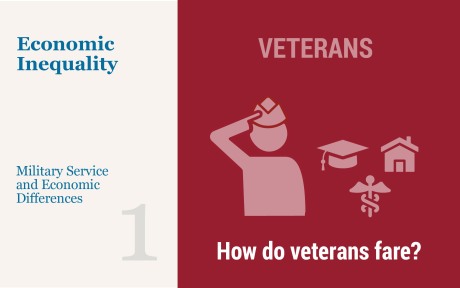Economics
The EGIs: Analyzing the Economy Through an Equitable Growth Lens
Inflation remains elevated, labor markets are close to the strongest they have been, real consumption is up year-over year, but all of these observations…


Inflation remains elevated, labor markets are close to the strongest they have been, real consumption is up year-over year, but all of these observations are with respect to averages. Behind these macroeconomic trends can be widely varying experiences across different demographic and socioeconomic groups that make up our society. To provide researchers, practitioners, and the public with timely, regularly updated and comprehensive answers to these questions, we launched the Equitable Growth Indicators (EGIs)—a new tool to help foster the evolving discussion about economic inequality and equitable growth. To illustrate the utility of the EGIs, we provide examples of some striking differences in trends captured in the May release of the EGIs on inflation, real earnings, and real spending. More heterogeneity analysis and data are available at nyfed.org/egi.
The EGIs Offer Insights That Other Metrics Cannot
Inflation: A centerpiece of the EGIs is to provide current measures of differential inflationary experiences. We advance current practice in economic research to account for how much people from different groups are exposed to price changes in their respective local areas (metro areas) based on the baskets of goods and services they consume. We assign consumption baskets to demographic groups separately by local areas and match each component of their consumption basket to prices prevailing in their local area. The constructed measures shown in the EGIs allow for a wider examination of inflation inequality across income and demographics than has been possible through customary sources or previous research.
For example, our differential inflation measure shows that, perhaps counterintuitively, middle-income consumers were hit hardest by inflation as it was picking up steam in 2021 through mid-2022. A natural question is why. Middle-income consumers (those in the 40th through 80th percentiles of household income) devote a larger share of their expenditures to used cars and motor fuel—perhaps because of the lower efficiency of the used cars—than do either high income (above 80th percentile) or low income (below 40th percentile) households. As the prices of these commodities soared, inflation for the middle class outstripped that of lower and higher income households. However, since mid-2022, as rising housing and food prices became more important factors for high inflation, the bottom 40 percent began bearing the brunt of inflation. The latest inflation data show that inflation for the bottom 40 percent was 0.2 percentage point above the national average, while inflation for the middle class and high-income households was 0.1 percentage point below the national average.
Low-Income Households Currently Face Markedly Higher Inflation than Middle- and High-Income Households
Percent share of expenses, by income group
Percent
Note: Expenditure shares use 2020 CEX microdata.
Overall inflation rates, by income group
Percent
Sources: BLS Consumer Expenditure Survey; BLS Consumer Price Indexes.
Note: Shaded region indicates the COVID-19 recession.
Earnings: Our differential inflation measures enable us to provide estimates of differences not just in nominal earnings, but in real earnings adjusted for the inflation that a given group experiences. This is another unique feature of the New York Fed EGIs—although nominal earnings differences can be obtained from publicly available Current Population Survey data, real earnings differences cannot. One might argue that the real earnings are more meaningful because they adjust for the purchasing power of households and better capture the differences in earnings across demographic and geographic groups.
This data in turn helps us understand the propagation of monetary policy throughout the economy. For example, while nominal earnings of both Black and Hispanic workers rose in the last two months, real weekly earnings of Black workers rose substantially in May but remained flat for Hispanic workers. Although both groups experienced increases in nominal earnings, Black workers experienced a steeper increase in nominal earnings and they experienced substantially lower inflation than did Hispanic, white, or AAPI workers.
Real Earnings for Black Workers Have Risen Substantially Since March
Weekly earnings (real) in dollars, by race
Notes: Real earnings use corresponding demographic prices, indexed to January 2020. Shaded region indicates the COVID-19 recession.
Consumer Spending: Another distinctive feature of the EGIs is the release of the demographic and geographic spending data. This release is made possible by proprietary high-frequency spending data that we receive from Commerce Signals. These data help us track differences in demographic and geographic retail spending patterns as they evolve over time. Additionally, not only do we make available nominal spending data, but we can calculate and report real spending data for demographic and geographic groups using the EGI inflation data.
Our headline chart for this measure, below, shows that after the pandemic, real retail spending grew fastest among younger people and slowest among older people. However, in the first few months of 2023, spending declined for all age groups and strikingly for the young. Individuals aged 25-34 are now spending less (relative to their January 2020 level) than individuals aged 35-44, reversing the original pattern. Although the spending of the young has stabilized in recent months, the decline in spending by the young may have important implications for economic activity over the medium term. Understanding and visualizing this heterogeneity would not have been possible without the demographic real spending data made available through the EGIs.
Consumer Spending Rose in May, Reversing the Decline Earlier This Year
Real retail spending, percent change
Notes: Real spending uses corresponding demographic prices, indexed to January 2020. Shaded region indicates the COVID-19 recession. Data from Jan. 1, 2020 to June 3, 2023.
Understanding the effects of monetary policy on various communities has always been an interest of central banking. In addition to the EGIs, the New York Fed has a few notable projects about various aspects of economic inequality:
- Bart Hobijn and David Lagakos wrote an early paper on inflation inequality back when they were at the New York Fed in 2003.
- The New York Fed Survey of Consumer Expectations and the Consumer Credit Panel are two data-intensive projects that have facilitated the measurement of heterogeneity, as well as the trend in consumers’ macroeconomic expectations and their financial health, respectively.
- Liberty Street Economics has addressed inequality-related issues since its inception in 2013 and has made a concerted effort to address them systematically with the inauguration of the Economic Inequality Research Series in October 2019.
The New York Fed EGI release makes available under a single umbrella a rich collection of data and analysis, much of which has been developed by our economists and/or relies on proprietary administrative sources, and hence is not available elsewhere.
Identifying Differing Economic Realities Helps Inform Policymaking
Particular groups may be bellwethers of broader economic trends important for monetary policy. We thus need to understand how different segments are affected by policy changes and to identify different economic realities across demographic and geographic groups. Not only are these data highly relevant for policymakers, but they also contain important insights that will be valuable for the general public, practitioners, and researchers.
Rajashri Chakrabarti is the head of Equitable Growth Studies in the Federal Reserve Bank of New York’s Research and Statistics Group.

Dan Garcia is a research analyst in the Federal Reserve Bank of New York’s Research and Statistics Group.
Maxim Pinkovskiy is an economic research advisor in Equitable Growth Studies in the Federal Reserve Bank of New York’s Research and Statistics Group.
How to cite this post:
Rajashri Chakrabarti, Dan Garcia, and Maxim Pinkovskiy, “The EGIs: Analyzing the Economy Through an Equitable Growth Lens,” Federal Reserve Bank of New York Liberty Street Economics, July 6, 2023, https://libertystreeteconomics.newyorkfed.org/2023/07/the-egis-analyzing-the-economy-through-an-equitable-growth-lens/.
Disclaimer
The views expressed in this post are those of the author(s) and do not necessarily reflect the position of the Federal Reserve Bank of New York or the Federal Reserve System. Any errors or omissions are the responsibility of the author(s).
inflation
commodities
monetary
markets
reserve
policy
fed
monetary policy
inflationary

Argentina Is One of the Most Regulated Countries in the World
In the coming days and weeks, we can expect further, far‐reaching reform proposals that will go through the Argentine congress.
Crypto, Crude, & Crap Stocks Rally As Yield Curve Steepens, Rate-Cut Hopes Soar
Crypto, Crude, & Crap Stocks Rally As Yield Curve Steepens, Rate-Cut Hopes Soar
A weird week of macro data – strong jobless claims but…
Fed Pivot: A Blend of Confidence and Folly
Fed Pivot: Charting a New Course in Economic Strategy Dec 22, 2023 Introduction In the dynamic world of economics, the Federal Reserve, the central bank…

















